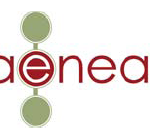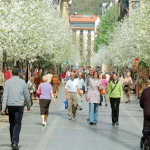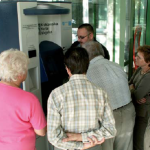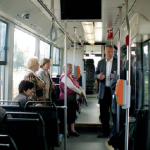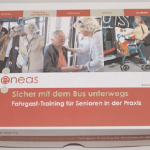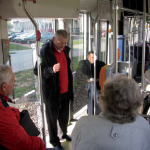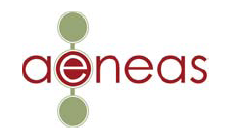
AENEAS, the acronym stands for “Attaining ENergy-Efficient
mobility in Ageing Society”, is a European project of the
Intelligent Energy Europe (EEI) programme. Given the significant
demographic challenge of a growing Older Population that is the
first ever cohort -male and female all the same- still using the
private car as a favourite mode of transport instead of more
sustainable modes of urban transport, the impact on energy
efficiency is considerable.
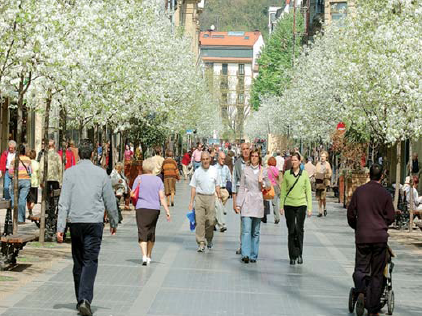
AENEAS looked at how to improve sustainable mobility in Older
Age, encouraging the shift towards soft modes cycling and
walking and the higher use of public transport.
The cities of San-Sebastian (Spain), Krakow (Poland) Odense
(Denmark), Salzburg (Austria) and Munich (Germany) were the
city partners of the project, ZGB an Austrian centre for geriatrics
provided the useful knowledge on the process of ageing and
AGE – the European platform representing Older People- and
EMTA supported the dissemination activities.
Five interactive and fruitful workshops were held, focussing
successively on “Understanding the mobility of Older People” in
Krakow June 2009, “Enhancing walking and traffic safety” in
San Sebastian October 2009, “Multimodal marketing for an
ageing society “ in Munich March 2010 and “Older passengers
It’s all about communication” in Salzburg November 2010.
The case for looking closely at mobility behaviour in older age
dates back to a study commissioned to Rupprecht Consult by
EMTA in 2007 [Older People and Public Transport [report 2007]] the findings enriched by the MOBILATE [[The MOBILATE Cohort study 1995-2000]] survey pointed out the following characteristics:
- Older People use public transport more frequently than
middle-aged persons. They also walk and cycle more and
use less the private car. - Older People cover shorter distances and make fewer trips
than younger people and devote less time to outdoor
activities. - Older people focus on proximity, trips are shorter they tend
to stay in the vicinity. - When analysing the mobility of Older People, age effects
and generation effects must be separated. It is unlikely that
a 75 old person in 2025 will have the same mobility
behaviour than a person of same age nowadays.
The workshops and related site visits were the opportunity to
observe as well remarkable practice related to enabling safe and
pleasant walking and cycling activities all taking part into the mobility
chain. However this article focuses on the aspects related to Public
transport and marketing and communication with Older Passengers.
What have we learned?
In the past 15 years or so, one of the major concerns about
passengers for the majority of transport authorities was the issue of
passengers with disabilities. Through the combined action of
national ad-hoc legislation and the European disability policy
impetus was given to “Access for All” to transport services and
facilities. The concept of people with reduced mobility was
invented including persons with disability, as well as parents with
toddlers, pregnant women, passengers with luggage and as a
natural consequence the older passengers.
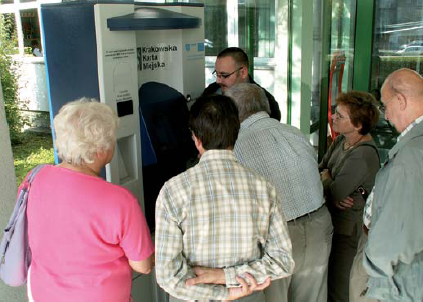
One of the major findings of AENEAS is that Older Passengers
deserve special attention. It isn’t simply a little of each sort
of disability concentrated into the same human being, it
definitely goes beyond.
What is it about?
Older people have expectations in using Public Transport more
than just getting from A to B. “A ride on the bus isn’t only a
mean to an end but rather an activity in itself “says Dr Christa
Erhart from Salzburg ZGB.
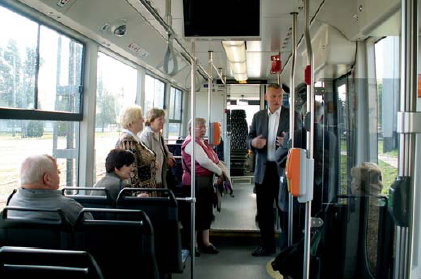
Difficulties may be posed by external physical barriers like the
ones transport authorities and operators learnt to overcome
progressively to accommodate the persons with disabilities such
as walking impairment, sight loss, hearing impairments. But it
goes beyond, rather it is about discomfort, about fears of falling,
fear of being bullied, also it is about difficulty in understanding
or processing information, it is more about lack of confidence.
Concerning communication with and information to Older People,
Dr Erhart explains the impact of ageing on communication skills.
Ageing translates into reduced structural and functional capacity,
compromise adaptability, less resistance to stress and slower
information processing. In short, sensory and tactile input is
reduced, information processing is slower, therefore reaction or
output is slower.
Drawing from Munich experience highlighted in a workshop in
March 2010, training is efficient. Be it training of older passengers
or training in the form of classes to get familiar with the internet
information. How to find the right timetable, how to find your
way through the network map, how to buy a ticket or use
the ticket-machine are reviewed. The point is Older People need
time to learn and several rehearsals.
One wonder should decision makers be concerned?
Salzburg operator Salzburg AG represented by Angelika Gasteiner
responsible for marketing and communication, says “30% of the
passengers nowadays are 60 plus years old, in 2025 we expect
50% of the passengers being over 60 years old”. Salzburg AG also
reckons that two thirds of the accidents occurring on the network
involve older passengers. Definitely taking into account this novel
issue is important.
In Sweden the STS services (specialised door to door services) were
put in place as early as 1970 offering services for users unable to
ride on conventional public transport mainly persons with disabilities
and also older people. Later on in the 90’ and under budget
pressure a new concept of flex-line [[consisting of minibuses services upon prior booking by telephone, taking passengers
at agreed meeting points “flex-lines” close to people’s home or centre of interest.]]was invented which proved
very popular among Older Passengers and helped ease the burden
on the costly STS services. And yet Gothenburg city council estimates
that a ride on flex-line services costs more than 10 times a
similar trip on public transport and therefore a new strategy towards
attracting Older People on regular lines would be of interest.
What can we draw as conclusions?
One of the topics debated during the workshops was about
the growing use of new technologies in the transport services.
Dr Erhart is of the opinion that it is good to use new technologies
with Older People like internet, mobile phone etc… but of course
it is necessary to work on the ergonomics and most of all allow
time for specific training.
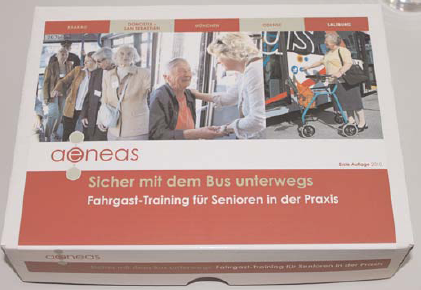
In the same way it is fine to have ticket-machine in the stations
instead of people selling at booths but the operator must provide
the human help when and where necessary. On London
Underground or Barcelona metro stations there are roaming staff
next to ticket machine or validators so as to provide assistance
to passengers if necessary. On Stockholm metro the operator MTR
is planning to have employees dedicated to customer care at
each entrance of the station at any time of the day in the coming
years; the measure is part of the “total quality concept”.
The second main topic was about marketing and communication.
How to reach Older Passengers as a target group is very
much about partnership. The city of Munich worked hand in
hand with the department for social and family affairs in order to
reach the right target, they also teamed up with Green City an
NGO with strong expertise in training Older People that developed
over the years classes for learning computer ability (for example
searching transport time tables or how to use a travel planner) or
safe-cycling.
In the city of Krakow the partnership was sealed with students
from the University to stand by at bus stops and offer assistance
to Older Passengers getting safely into or alighting from the bus.
San Sebastian city worked in close collaboration with a focus
group and a Road Safety association to review the dysfunctions
in the walking path for the benefit of all pedestrians including
those trying to reach the next transport stop. The achievement
of Salzburg AG in the training of bus drivers as well as ageing
passengers has largely benefited from the expertise of ZGB a
institution specialised in geriatrics.
What role for the transport authorities?
When asked what in their view, the transport authorities could
do to help attract and retain Older Passengers, the partners of
the project summarized in the following way:
It’s all about quality about improving the travel experience for all
passengers including older passengers. For many Older People,
the ride on a bus isn’t only a mean to an end but also an activity in
itself. The quality of service combined with appropriate training
should result in the “empowering” of the vulnerable passengers.
They there fore suggest to:
- Act as the facilitator between the operator and the user
groups (Krakow). - Ensure all operators of the metropolitan transport network
are aware of the growing weight of Older People amongst
their daily passengers and that their employees are or will
be exposed to a training on Older Passengers needs and
how to respond (Salzburg). - Keep in mind the overall objective of sustainable mobility
and transport efficiency and encourage as much as possible
the use of friendly-to-all regular services. - Think about inserting into tendering specifications awareness
training to Older Passengers needs. - Work both ways: adapt the system and also see to Older
People adapting to the system: how to behave safely when
riding public transport, how to get proper information on
various channel and new media etc… for this purpose use
the excellent videos on training (both passengers and staff)
soon to be available as a valuable outcome of the project. - Spread the word, for not all transport authorities have had
the opportunity to hear about the AENEAS project.
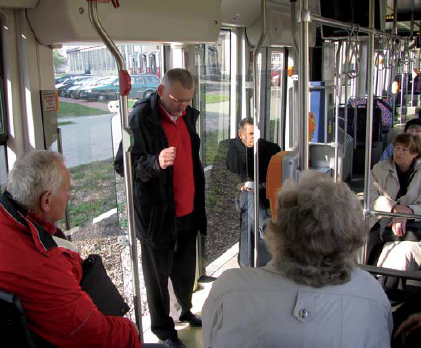
“The demography will soon close the opportunity
window” says Dr Ralf Risser expert in marketing.
It means that the unbalance in demography
will soon be overwhelming and changes will
have to happen very quickly instead of allowing
smooth adaptation.
Contact: www.aeneas-project.eu
